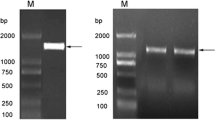Abstract
Aspartokinase (EC 2.7.2.4) and homoserine dehydrogenase (EC 1.1.1.3) catalyze steps in the pathway for the synthesis of lysine, threonine, and methionine from aspartate. Homoserine dehydrogenase was purified from carrot (Daucus carota L.) cell cultures and portions of it were subjected to amino acid sequencing. Oligonucleotides deduced from the amino acid sequences were used as primers in a polymerase chain reaction to amplify a DNA fragment using DNA derived from carrot cell culture mRNA as template. The amplification product was radiolabelled and used as a probe to identify cDNA clones from libraries derived from carrot cell culture and root RNA. Two overlapping clones were isolated. Together the cDNA clones delineate a 3089 bp long sequence encompassing an open reading frame encoding 921 amino acids, including the mature protein and a long chloroplast transit peptide. The deduced amino acid sequence has high homology with the Escherichia coli proteins aspartokinase I-homoserine dehydrogenase I and aspartokinase II-homoserine dehydrogenase II. Like the E. coli genes the isolated carrot cDNA appears to encode a bifunctional aspartokinase-homoserine dehydrogenase enzyme.
Similar content being viewed by others
Abbreviations
- AK:
-
aspartokinase
- HSDH:
-
homoserine dehydrogenase
- PCR:
-
polymerase chain reaction
- SDS:
-
sodium dodecyl sulfate
References
Bryan JK: Synthesis of the aspartate family and branched-chain amino acids. In: Miflin BJ (ed) The Biochemistry of Plants: A comprehensive Treatise, vol. 5, pp. 329–357. Academic Press, New York (1980).
Bryan JK, Lissik EA, Matthews BF: Changes in enzyme regulation during growth of maize. III. Intracellular localization of homoserine dehydrogenase in chloroplasts. Plant Physiol 59: 673–679 (1977).
Chirgwin JM, Przybyla AE, MacDonald RJ, Rutter WI: Isolation of biologically active ribonucleic acid from sources enriched in ribonuclease. Biochemistry 18: 5294–5299 (1979).
Cohen GN: The common pathway to lysine, methionine and threonine. In: Herrmann KM, Somerville RL (eds) Amino Acids: Biosynthesis and Genetic Regulation, pp. 147–171. Addison-Wesley, Reading, MA (1983).
Cohen GN, Saint-Girons I: Biosynthesis of threonine, lysine and methionine. In: Neidhardt FC (ed) Escherichia coli and Salmonella typhimurium: Cellular and Molecular Biology, pp. 429–444. American Society for Microbiology, Washington, DC (1987).
Cohen GN, Stanier RY, Le Bras G: Regulation of the biosynthesis of the amino acids of the aspartate family in coliform bacteria and pseudomonads. J Bact 99: 791–801 (1969).
Feinberg AP, Vogelstein B: A technique for radiolabeling DNA restriction endonuclease fragments to high specific activity. Anal Biochem 132: 6–13 (1983).
Kaneko T, Hashimoto T, Kumpaisal R, Yamada Y: Molecular cloning of wheat dihydrodipicolinate synthase. J Biol Chem 265: 17451–17455 (1990).
Keegstra K, Olsen LJ, Theg SM: Chloroplastic precursors and their transport across the envelope membranes. Annu Rev Plant Physiol Plant Mol Biol 40: 471–501 (1989).
Keim P, Olson TC, Shoemaker RC: A rapid protocol for isolating soybean DNA. Soybean Genet Newsl 15: 150–152 (1988).
Lea PJ, Mills WR, Miflin BJ: The isolation of a lysine-sensitive aspartate kinase from pea leaves and its involvement in homoserine biosynthesis in isolated chloroplasts. FEBS Lett 98: 165–168 (1979).
Maniatis T, Fritsch EF, Sambrook J: Molecular Cloning: A Laboratory Manual. Cold Spring Harbor Laboratory, Cold Spring Harbor, NY (1982).
Matthews BF, Farrar MJ, Gray AC: Purification and interconversion of homoserine dehydrogenase from Daucus carota cell suspension cultures. Plant Physiol 91: 1569–1574 (1989).
Matthews BF, Widholm JM: Regulation of lysine and threonine synthesis in carrot cell suspension cultures and whole carrot roots. Planta 141: 315–321 (1978).
Mills WR, Wilson KG: Effects of lysine, threonine and methionine on light-driven protein synthesis in isolated pea (Pisum sativum L.) chloroplasts. Planta 142: 153–160 (1978).
Parsot C, Cohen GN: Cloning and nucleotide sequence of the Bacillus subtilis hom gene coding for homoserine dehydrogenase. J Biol Chem 263: 14654–14660 (1988).
Rafalski JA, Falco SC: Structure of the yeast HOM gene which encodes aspartokinase. J Biol Chem 263: 2146–2151 (1988).
Robert-Gero M, Le Borgne L, Cohen GN: Concerted feedback inhibition of the aspartokinase of Rhodospirrilum tenue by threonine and methionine: a novel pattern. J Bact 112: 251–258 (1972).
Sainis JK, Mayne RG, Wallsgrove RM, Lea PJ, Miflin BJ: Localization and characterization of homoserine dehydrogenase isolated from barley and pea leaves. Planta 152: 491–496 (1981).
Sanger F, Nicklen S, Coulson AR: DNA sequencing with the chain terminating inhibitors. Proc Natl Acad Sci USA 74: 5463–5467 (1977).
Turano FJ, Jordan RL, Matthews BF: Immunological characterization of in vitro forms of homoserine dehydrogenase from carrot suspension cultures. Plant Physiol 92: 395–400 (1990).
Turano FJ, Weisemann JM, Matthews BF: Identification and expression of a cDNA clone encoding aspartate aminotransferase in carrot. Plant Physiol 100: 374–381 (1992).
Wallsgrove RM, Lea PJ, Miflin BJ: Intracellular localization of aspartate kinase and the enzymes of threonine and methionine biosynthesis in green leaves. Plant Physiol 71: 780–784 (1983).
Wilson BJ, Gray AC, Matthews BF: Bifunctional protein in carrot contains both aspartokinase and homoserine dehydrogenase activities. Plant Physiol 97: 1323–1328 (1991).
Zakin MM, Duchange N, Ferrara P, Cohen GN: Nucleotide sequence of the metL gene of Escherichia coli. J Biol Chem 258: 3028–3031 (1983).
Author information
Authors and Affiliations
Additional information
The mention of vendor or product does not imply that they are endorsed or recommended by the U.S. Department of Agriculture over vendors of similar products not mentioned.
Rights and permissions
About this article
Cite this article
Weisemann, J.M., Matthews, B.F. Identification and expression of a cDNA from Daucus carota encoding a bifunctional aspartokinase-homoserine dehydrogenase. Plant Mol Biol 22, 301–312 (1993). https://doi.org/10.1007/BF00014937
Received:
Accepted:
Issue Date:
DOI: https://doi.org/10.1007/BF00014937




